Page 80 of 173
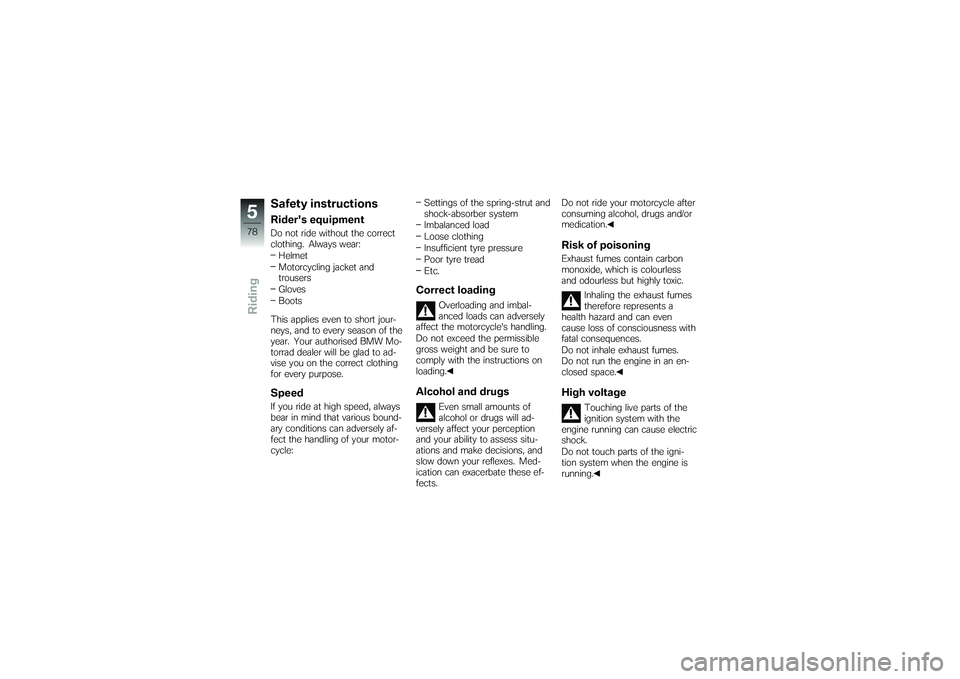
Safety instructionsRider's equipmentDo not ride without the correct
clothing. Always wear:Helmet
Motorcycling jacket and
trousers
Gloves
Boots
This applies even to short jour-
neys, and to every season of the
year. Your authorised BMW Mo-
torrad dealer will be glad to ad-
vise you on the correct clothing
for every purpose.SpeedIf you ride at high speed, always
bear in mind that various bound-
ary conditions can adversely af-
fect the handling of your motor-
cycle: Settings of the spring-strut and
shock-absorber system
Imbalanced load
Loose clothing
Insufficient tyre pressure
Poor tyre tread
Etc.
Correct loading
Overloading and imbal-
anced loads can adversely
affect the motorcycle's handling.
Do not exceed the permissible
gross weight and be sure to
comply with the instructions on
loading.
Alcohol and drugs
Even small amounts of
alcohol or drugs will ad-
versely affect your perception
and your ability to assess situ-
ations and make decisions, and
slow down your reflexes. Med-
ication can exacerbate these ef-
fects. Do not ride your motorcycle after
consuming alcohol, drugs and/or
medication.
Risk of poisoningExhaust fumes contain carbon
monoxide, which is colourless
and odourless but highly toxic.
Inhaling the exhaust fumes
therefore represents a
health hazard and can even
cause loss of consciousness with
fatal consequences.
Do not inhale exhaust fumes.
Do not run the engine in an en-
closed space.High voltage
Touching live parts of the
ignition system with the
engine running can cause electric
shock.
Do not touch parts of the igni-
tion system when the engine is
running.
578zRiding
Page 82 of 173
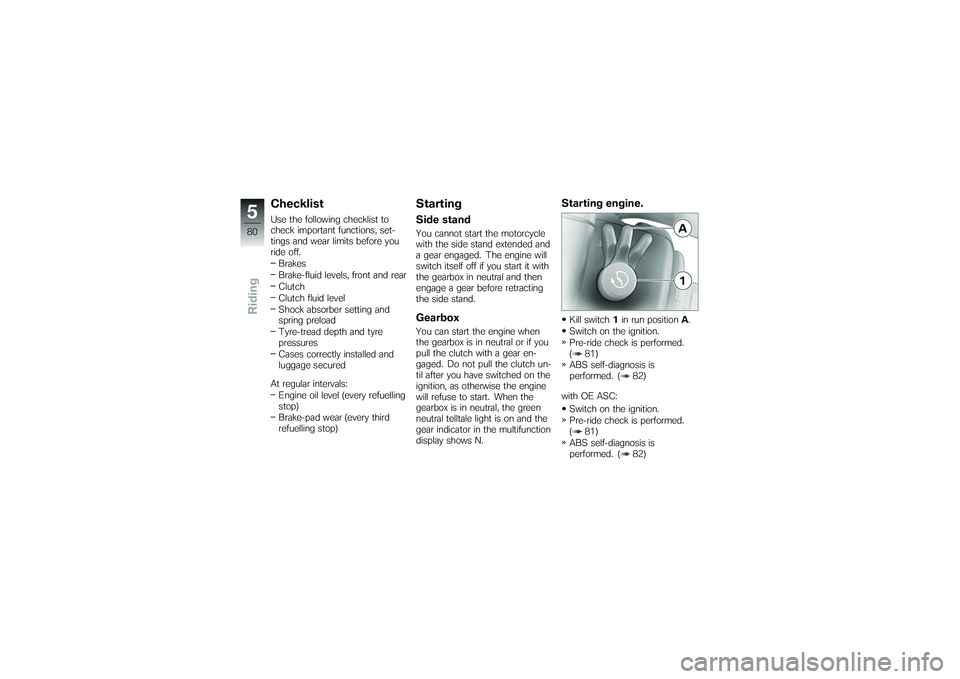
ChecklistUse the following checklist to
check important functions, set-
tings and wear limits before you
ride off.Brakes
Brake-fluid levels, front and rear
Clutch
Clutch fluid level
Shock absorber setting and
spring preload
Tyre-tread depth and tyre
pressures
Cases correctly installed and
luggage secured
At regular intervals: Engine oil level (every refuelling
stop)
Brake-pad wear (every third
refuelling stop)
StartingSide standYou cannot start the motorcycle
with the side stand extended and
a gear engaged. The engine will
switch itself off if you start it with
the gearbox in neutral and then
engage a gear before retracting
the side stand.GearboxYou can start the engine when
the gearbox is in neutral or if you
pull the clutch with a gear en-
gaged. Do not pull the clutch un-
til after you have switched on the
ignition, as otherwise the engine
will refuse to start. When the
gearbox is in neutral, the green
neutral telltale light is on and the
gear indicator in the multifunction
display shows N.
Starting engine.Kill switch 1in run position A.
Switch on the ignition.
Pre-ride check is performed.
( 81)
ABS self-diagnosis is
performed. ( 82)
with OE ASC: Switch on the ignition.
Pre-ride check is performed.
( 81)
ABS self-diagnosis is
performed. ( 82)
580zRiding
Page 85 of 173
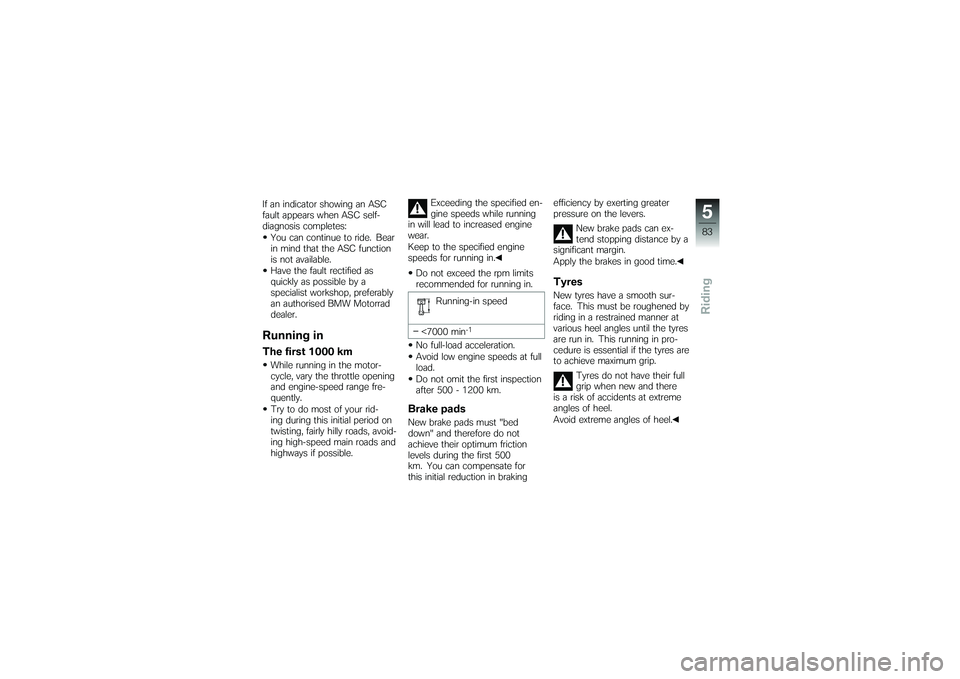
If an indicator showing an ASC
fault appears when ASC self-
diagnosis completes:You can continue to ride. Bear
in mind that the ASC function
is not available.
Have the fault rectified as
quickly as possible by a
specialist workshop, preferably
an authorised BMW Motorrad
dealer.Running inThe first 1000 kmWhile running in the motor-
cycle, vary the throttle opening
and engine-speed range fre-
quently.
Try to do most of your rid-
ing during this initial period on
twisting, fairly hilly roads, avoid-
ing high-speed main roads and
highways if possible. Exceeding the specified en-
gine speeds while running
in will lead to increased engine
wear.
Keep to the specified engine
speeds for running in.
Do not exceed the rpm limits
recommended for running in.
Running-in speed
<7000 min
-1
No full-load acceleration.
Avoid low engine speeds at full
load.
Do not omit the first inspection
after 500 - 1200 km.Brake padsNew brake pads must "bed
down" and therefore do not
achieve their optimum friction
levels during the first 500
km. You can compensate for
this initial reduction in braking efficiency by exerting greater
pressure on the levers.
New brake pads can ex-
tend stopping distance by a
significant margin.
Apply the brakes in good time.
TyresNew tyres have a smooth sur-
face. This must be roughened by
riding in a restrained manner at
various heel angles until the tyres
are run in. This running in pro-
cedure is essential if the tyres are
to achieve maximum grip.
Tyres do not have their full
grip when new and there
is a risk of accidents at extreme
angles of heel.
Avoid extreme angles of heel.
583zRiding
Page 91 of 173
Engineering details
Engineering details
Brake system with BMW Motorrad
Integral ABS . ........................ 90
Electronic engine management with
BMW Motorrad ASC
OE
.............. 92
Tyre pressure monitoring
RDC
OE
.............................. 94
689zEngineering details
Page 93 of 173
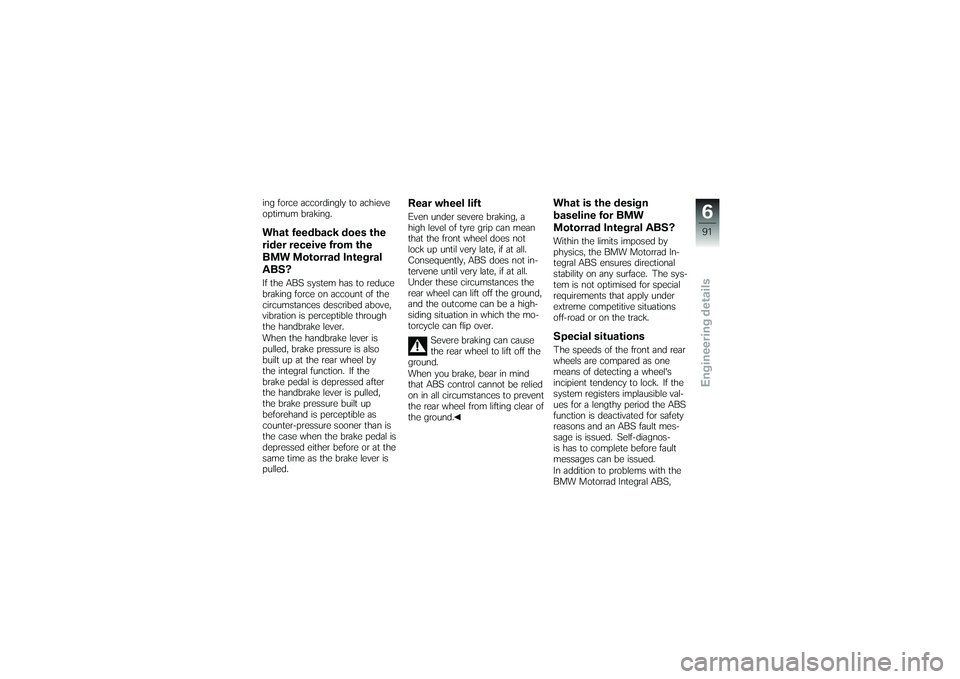
ing force accordingly to achieve
optimum braking.What feedback does the
rider receive from the
BMW Motorrad Integral
ABS?If the ABS system has to reduce
braking force on account of the
circumstances described above,
vibration is perceptible through
the handbrake lever.
When the handbrake lever is
pulled, brake pressure is also
built up at the rear wheel by
the integral function. If the
brake pedal is depressed after
the handbrake lever is pulled,
the brake pressure built up
beforehand is perceptible as
counter-pressure sooner than is
the case when the brake pedal is
depressed either before or at the
same time as the brake lever is
pulled.
Rear wheel liftEven under severe braking, a
high level of tyre grip can mean
that the front wheel does not
lock up until very late, if at all.
Consequently, ABS does not in-
tervene until very late, if at all.
Under these circumstances the
rear wheel can lift off the ground,
and the outcome can be a high-
siding situation in which the mo-
torcycle can flip over.Severe braking can cause
the rear wheel to lift off the
ground.
When you brake, bear in mind
that ABS control cannot be relied
on in all circumstances to prevent
the rear wheel from lifting clear of
the ground.
What is the design
baseline for BMW
Motorrad Integral ABS?Within the limits imposed by
physics, the BMW Motorrad In-
tegral ABS ensures directional
stability on any surface. The sys-
tem is not optimised for special
requirements that apply under
extreme competitive situations
off-road or on the track.Special situationsThe speeds of the front and rear
wheels are compared as one
means of detecting a wheel's
incipient tendency to lock. If the
system registers implausible val-
ues for a lengthy period the ABS
function is deactivated for safety
reasons and an ABS fault mes-
sage is issued. Self-diagnos-
is has to complete before fault
messages can be issued.
In addition to problems with the
BMW Motorrad Integral ABS,
691zEngineering details
Page 96 of 173
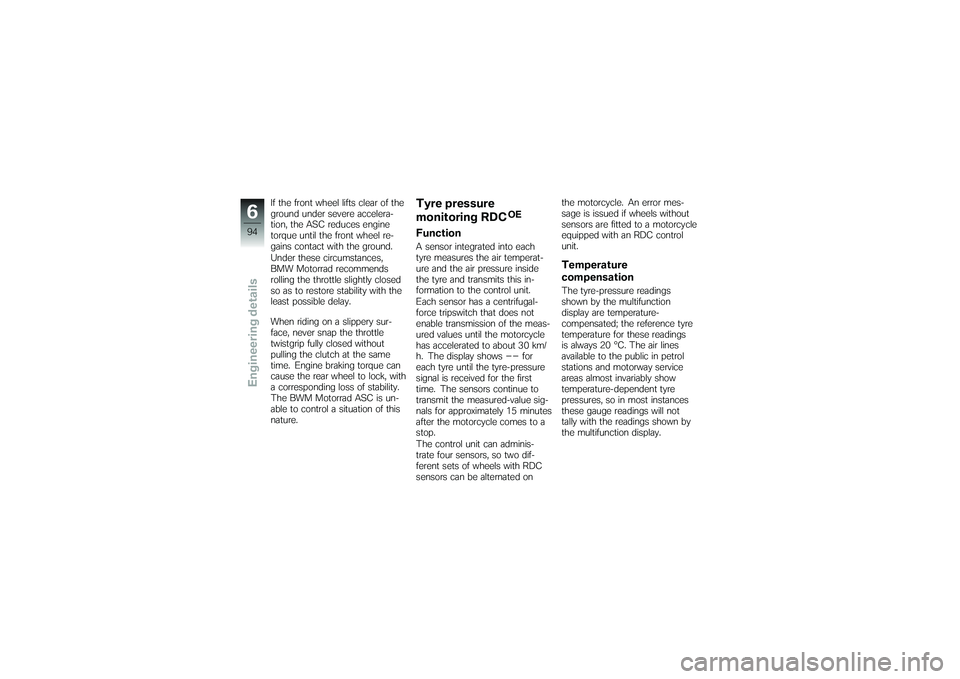
If the front wheel lifts clear of the
ground under severe accelera-
tion, the ASC reduces engine
torque until the front wheel re-
gains contact with the ground.
Under these circumstances,
BMW Motorrad recommends
rolling the throttle slightly closed
so as to restore stability with the
least possible delay.
When riding on a slippery sur-
face, never snap the throttle
twistgrip fully closed without
pulling the clutch at the same
time. Engine braking torque can
cause the rear wheel to lock, with
a corresponding loss of stability.
The BWM Motorrad ASC is un-
able to control a situation of this
nature.
Tyre pressure
monitoring RDC
OE
FunctionA sensor integrated into each
tyre measures the air temperat-
ure and the air pressure inside
the tyre and transmits this in-
formation to the control unit.
Each sensor has a centrifugal-
force tripswitch that does not
enable transmission of the meas-
ured values until the motorcycle
has accelerated to about 30 km/
h. The display shows
--
for
each tyre until the tyre-pressure
signal is received for the first
time. The sensors continue to
transmit the measured-value sig-
nals for approximately 15 minutes
after the motorcycle comes to a
stop.
The control unit can adminis-
trate four sensors, so two dif-
ferent sets of wheels with RDC
sensors can be alternated on the motorcycle. An error mes-
sage is issued if wheels without
sensors are fitted to a motorcycle
equipped with an RDC control
unit.
Temperature
compensationThe tyre-pressure readings
shown by the multifunction
display are temperature-
compensated; the reference tyre
temperature for these readings
is always 20 °C. The air lines
available to the public in petrol
stations and motorway service
areas almost invariably show
temperature-dependent tyre
pressures, so in most instances
these gauge readings will not
tally with the readings shown by
the multifunction display.
694zEngineering details
Page 97 of 173
Tyre-pressure rangesThe RDC control unit differenti-
ates between three air-pressure
ranges, all of which are paramet-
erised for the motorcycle:Air pressure within permitted
tolerance.
Air pressure close to limit of
permitted tolerance.
Air pressure outside permitted
tolerance.
695zEngineering details
Page 101 of 173
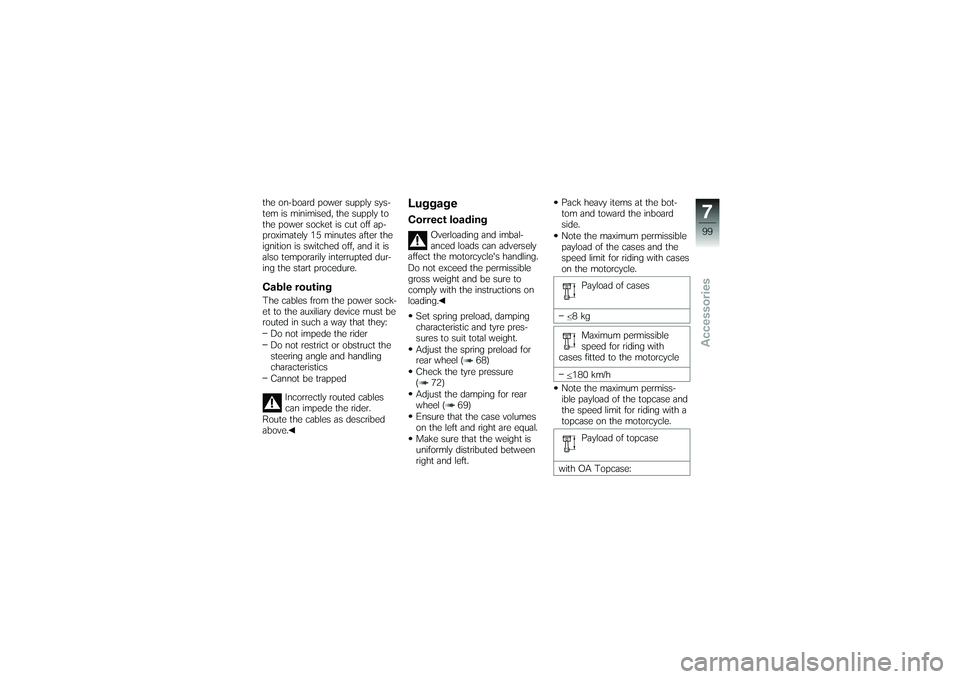
the on-board power supply sys-
tem is minimised, the supply to
the power socket is cut off ap-
proximately 15 minutes after the
ignition is switched off, and it is
also temporarily interrupted dur-
ing the start procedure.Cable routingThe cables from the power sock-
et to the auxiliary device must be
routed in such a way that they:Do not impede the rider
Do not restrict or obstruct the
steering angle and handling
characteristics
Cannot be trapped
Incorrectly routed cables
can impede the rider.
Route the cables as described
above.
LuggageCorrect loading
Overloading and imbal-
anced loads can adversely
affect the motorcycle's handling.
Do not exceed the permissible
gross weight and be sure to
comply with the instructions on
loading.
Set spring preload, damping
characteristic and tyre pres-
sures to suit total weight.
Adjust the spring preload for
rear wheel ( 68)
Check the tyre pressure
( 72)
Adjust the damping for rear
wheel ( 69)
Ensure that the case volumes
on the left and right are equal.
Make sure that the weight is
uniformly distributed between
right and left. Pack heavy items at the bot-
tom and toward the inboard
side.
Note the maximum permissible
payload of the cases and the
speed limit for riding with cases
on the motorcycle.
Payload of cases
8kg Maximum permissible
speed for riding with
cases fitted to the motorcycle
180 km/h
Note the maximum permiss-
ible payload of the topcase and
the speed limit for riding with a
topcase on the motorcycle.
Payload of topcase
with OA Topcase:
799zAccessories